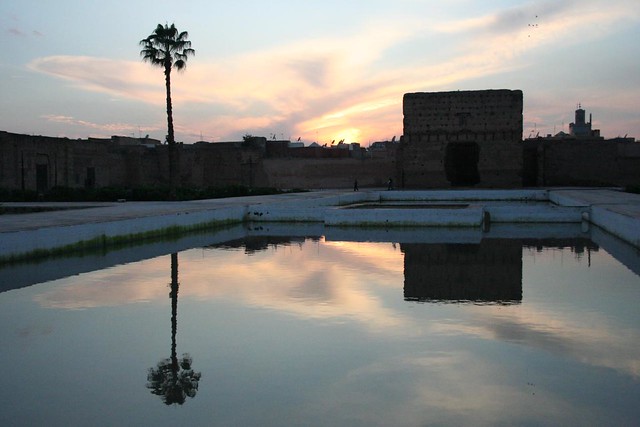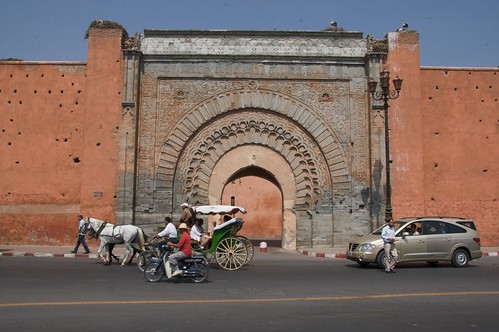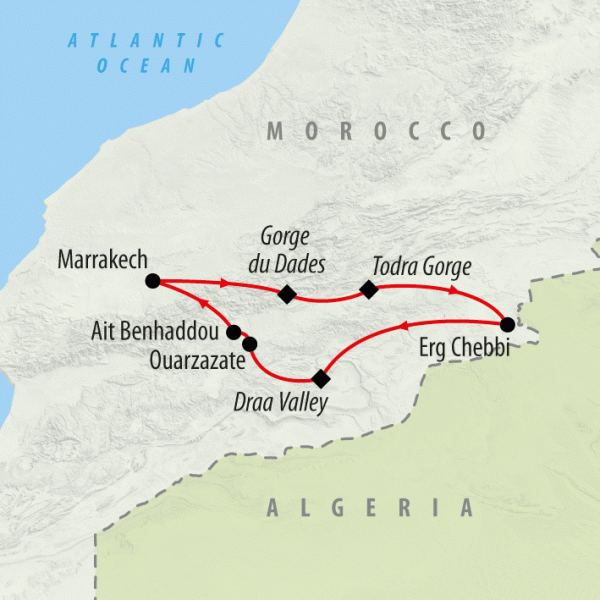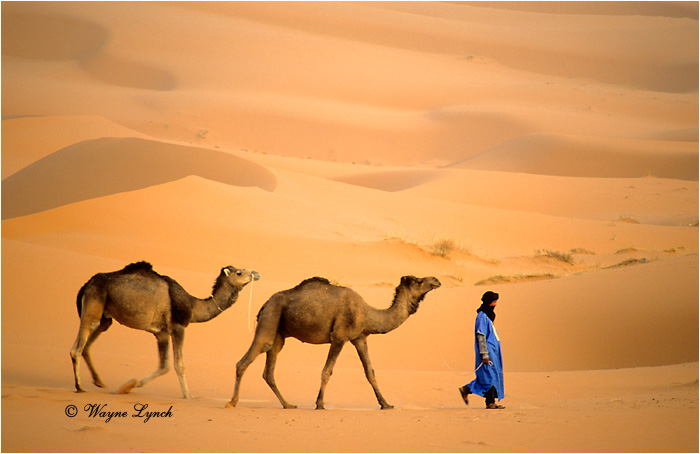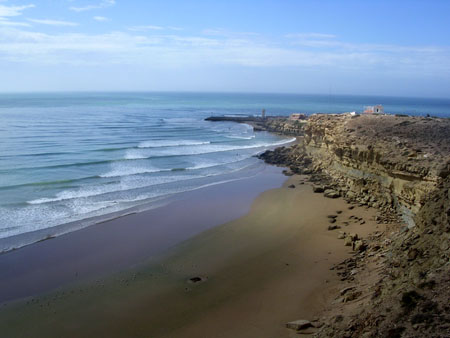Marrakech History
Achaeologists have found that the site of Marrakech has been almost continually occupied since Neolithic times, but the modern city has its origins in an Almoravids garrison town of the 11th century. In 1062, Abu Bekr, an early commander of the Almoravids, threw up a wall of thorn bushes to protect his camp and built a fortress amid his tented army, the Ksar el Hajar,the tower of stone. Nine years later he appointed his young cousin, Youssef ben Tachafine, to command this new post. The meteoric conquest of Morocco and spain by Youssef ben Tachafine from this base marks the true foundation of both the city and the Almoravid Empire. Marrakech's position on the border of three agricultural regions meant that it soon eclipsed the older towns of Aghmat and Nfis to become the main market for the farmers of the Tensift valley, the nomadic pastoralists of plains and the Masmuda Atlas tribes. It still has that feel to this day. It was Youssef ben Tachafine's son and successor, Ali ben Youssef, who built the great circuit of walls, two large mosques, palaces and fountains, which were all superbly decorated by Andalucian carvers.


The Almoravids brought the technology of desert survival and used it to improve the city's seasonal water supply. Long khettera (pipes) were built to carry water underground from the High Atlas mountains to the houses and gardens of Marrakech.
The Capital City Of The Almohad Empire 1147 - 1269
After Decades of warfare between the Almoravid Sultans and the Almohads, whose head-quarters were tucked up in the High Atlas moutains, the walled city of Marrakech finally fell in 1147. The Almohads deliverately demolished any evidence of the previous dynasty and remade the city their own image. It did, however, remain the capital city of a great empire, and the monumental buildings of this period-the Koutoubia Mosque, the El Mansour Mosque, the Bab Agnaou-still dominate the city. Almohad princes ruled on in Marrakech decades after the rest of their empire had fallen into hands of rival dynasties. Like the Almoravids before them, they were fated to die defending the walls of the city, which were finally breached by the Merenids in 1269.


A Decaying City 1262 - 1524
Under the Merenids Sultans (1248-1465) Morocco was ruled from Fez, and Marrakech stagnated into a provincial town. By the early years of the 16th century even this comparative prosperity had ended. Portuguese cavalry raided up to the walls of the city, Ottaman Turks were poised to advance from the east, and the authority of the central government, threatened by dozens of rival dynasties, had shrunk to the area around Fez. In 1524 the dilapidated city welcomed the rule of Mohammed ech Cheikh, forceful founder of the Saadian dynasty, whose power was based on the tribes of the south. Using Marrakech as his base, Mohammed ech Cheikh succeeded in subduing the rest of the country. He was murdered in a High Atlas valley by an Ottman assassination squad. The governor of Marrakech prompty ordered the murder of six of his sons, to clear the succession for Abdullah el Ghalib.

The Golden Capital Of Saadians 1524 - 1668
The reigns of Abdullah el Ghalib and his half-brother Ahmed el Mansour, the victorious (also known as El Dehbi, the golden), witnessed a magnificent revival in the prosperity of Marrakech. Abdullah founded the mellah, rebuilt the Kasbah and the Ben Youssef Mosque and Medersa, and built a hospital and the new Mouassine Mosque. Ahmed el Mansour built the incomparable El Badia Palace and the Saadian Tombs, and sprinkled the city with fountains, foundouqs, libraries and hammams. The prosperity of Marrakech in these centuries was partly based on a thriving trade in sugar, saltpetre, cotton and silk. The city become the collection and transit point for the produce of the Sahara and sub-Sahara-slaves, gold, ivory, gum arabic and ostrich feathers-which was then exported through the Atlantic ports.

Alaouite Marrakech, The twin Capital 1668 - 1912
The vicious civil wars of the late 17th and early 18th centuries, in which Marrakech was repeatedly beseiged and plundered, were a disaster from which it never entirely recovered. Sultan Moulay Ismail (1672 - 1727) restored the religious shrines of the city but decided to rule from a new capital in Meknes. Later Alaouite sultans attempted to check the city's continued decline by alternating government between Fez and Marrakech, and many of the city's finest buildings date from the 18th and 19th centuries. The comparative order and prosperity of Moulay Hassan's reign (1873 - 94) is revealed in the large number of opulent merchants houses and palaces of the Bahia and Dar Si Said, built by viziers during the minority of his son, Abdul Aziz.
But the City remained pitifully backward. At the turn of the 20th century there were no wind or steam mills in the city, and trade depended on pack animals being safely escorted past the Rehamna tribes to Essaouira.
The 20th Century And Beyond
Growing European influence was bitterly resented, culminating in the lynching of a French resident, a Dr Mauchamp, after he attached an aerial to his roof in 1907. Personal resentment against Dr Mauchamp was intense, from both native healers and city traders who were influriated that with his aerial the doctor could dicover prices in Essaouira days before they could. The city mob for their part were convinced the aerial was a sorcerer's device, for i twas well known on the streets, and with some truth, that Mauchamp had great knowledge of the occult. This lynching proved to be one of several incidents that provided the excuse for the french landings in Casablanca in the same year. Five years later the French army occupied the city, having destroyed the tribal army of El Hiba, the Blue Sultan, at Sidi-Bou-Othman.

Marrakech become an important centre of French infulence in the south, though the city sold predominance was deliberately shattered with the location of the new commercial centre at Casablanca. In Marrakech the French buit a new town, Guéliz, to the west of the old city, its ordered avenues and quit leafy suburbs overlooked by their enormous army barracks. Within a generation they had adorned the region with roads, hotels, pylons, railways, schools, irrigation works and hospitals. Apart from the roads, these technical advances were for the benifit of colonial farmers and the caidal allies of the French. Their chief ally was Si Thami el Glaoui, the fabulously wealthy Pasha of Marrakech, who ruled a medina in which an estimated 20,000 registered prostitutes lived.

Independence in 1956 bright a swift and bloody end to the pasha's corrupt regime. Greater Marrakech today houses a rapidly expanding population of a million. It is the most important administrative and intustrial centre of the south, and earns valuable foreign currency as a tourist destination. Marrakech is a natural marketplace, with a cultural life that recalls both the splendour ofits periods as imperial capital and the traditions of its rural Berber hinterland.
in morocco,moroccan culture,hercules cave,hercules cave morocco


